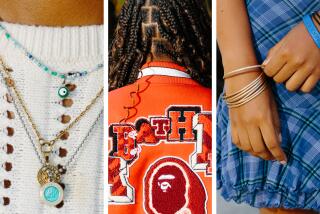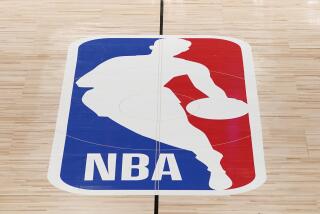Dress Code Suits Him
- Share via
Any time we’re talking about the image of the NBA, we’re talking about the perception of the African American male.
So there’s no way around the topic of race and its role in the league’s new dress code. Not when almost 80% of the players are black, according to figures through last season.
But it’s too simplistic to say this is strictly a matter of Commissioner David Stern trying to wipe out the hip-hop wear so he can package the league to White America. First of all, does that mean black people don’t want to see young men dress professionally? Does it imply that classy means “white” and casual means “black”? (Um, who do you think is keeping Birkenstock in business?)
So even though Stern’s less-50-Cent-more-dollar-worthy objective makes the league more palatable to baby boomers and to all of the folks in charge of sales and marketing at the big companies, guess who will be the biggest beneficiary of the NBA’s new “business casual” standard of at least slacks and collared shirts for team events? Young black males.
It’s what former Georgetown coach John Thompson calls “unintended education.”
I’m in favor of Stern’s new rules strictly for the byproduct: It will be good for black kids to see black professionals dressed professionally. They should associate that with success, because in all reality they stand a much better chance of landing a well-paying job that requires them to wear wingtips rather than an NBA career wearing Nikes.
One of the sharpest lines to ever come out of Chuck D’s mouth was in the title song on the “He Got Game” soundtrack.
“White men in suits don’t have to jump,” Chuck said.
It was a reminder to forget about the supposed athleticism gap played up in “White Men Can’t Jump” and focus on what’s really important: the uniform that represents employable skills.
There’s a corporate backlash to the creeping casualness in offices. A USA Today story referenced a 2005 survey in which 49% of employers said that “non-traditional attire would have a ‘strong influence’ on their opinion of a candidate” -- up 11% from the 2002 survey.
There are enough negative stereotypes surrounding blacks that they can’t afford to have “slacker” added to the list just by what they wear. The best tip I learned from the college internship I did with a Chicago TV reporter named Art Norman came in a phone conversation before I started.
“Wear a tie,” Norman told me. “As a black man, that’s your badge of respect.”
John Thompson wore a tie every day as a student at Brown Junior High in Washington D.C, five decades ago. There were no white people in sight. Didn’t matter. It’s what was right.
Unfair dress requirements? He always thought it was a dumb idea for college basketball coaches who were constantly hopping out of their seats, pacing the sidelines and squeezing between sweaty players in the huddle to have to wear business attire.
“But you were representing the university,” Thompson said. “That’s the most idiotic thing I’ve ever seen, to have to wear a coat and tie [while coaching]. I didn’t like that. But all of us have to do some things.”
One of the reasons some players are reacting negatively to the dress code is they’re not used to having the rules of society apply to them. I can’t tell you how many times I’ve been to nightclubs with strict no-hats, no-sneakers policies, only to see NBA players and their boys clad in caps and sneakers roll right in.
Thompson is one of the most independent thinkers on the sports landscape. He kept a tight wrap around his program no matter what the outsiders thought. He was so committed to his principles that he walked off the court to protest NCAA legislation he believed adversely affected minorities.
But he was wearing a coat and tie when he did it. Because long ago he learned a bit of truth that just hit the NBA players.
“Somebody in life’s in charge -- and it ain’t always you,” Thompson said. “That’s the biggest lesson that [Stern’s] teaching.”
Thompson was in charge at Georgetown. He had a dress code that applied to everyone -- even a freshman with a troubled background named Allen Iverson.
“Allen wore a coat and tie,” Thompson said, “and didn’t rebel against wearing it.”
It usually was a jacket that looked as if it were cut from the same bolt of fabric as Bear Bryant’s hat. It was all he could afford. Once Iverson hit the pros and had the money, he chose comfort over custom wardrobe. He even wore a do-rag when he accepted his rookie-of-the-year trophy from a horrified Stern.
So Iverson has become the runway model for the look the league wants to eliminate, and Iverson has also been the voice of dissent.
“I respect and love Allen, but I differ with his opinion on this,” Thompson said. “I think this is based on some of the things that have occurred in the league over the last year [most notably the player-fan melee in Detroit]. If nothing else, you’ve got a perception problem.”
So we’re back to perception. One of the benefits black people don’t enjoy is the freedom to be judged on one’s individual actions, not by the race as a whole. When Timothy McVeigh blew up a federal building in Oklahoma, the profile of a terrorist wasn’t reset to a white man with a crew cut. It’s the opposite situation with Iverson, who has come to represent the NBA even though most players already meet or exceed the new dress requirements.
It also means he has the power to change it. Remember, this is the same player whose attire in the summer of 2004 was red, white and blue, when most of the league’s top stars bailed out on representing their country in the Olympics.
“Allen is not a hard sell,” Thompson said. “He’ll stand up for what he believes, but he can be easily convinced if he believes it’s for the good of young kids.”
And that’s what the dress code is, regardless of why it came into existence.
*
J.A. Adande can be reached at j.a.adande@latimes.com. To read previous columns by Adande go to latimes.com/Adande
More to Read
Go beyond the scoreboard
Get the latest on L.A.'s teams in the daily Sports Report newsletter.
You may occasionally receive promotional content from the Los Angeles Times.










